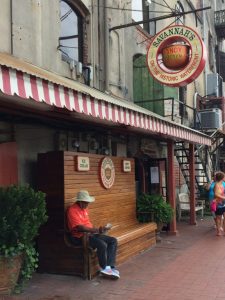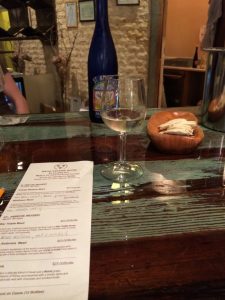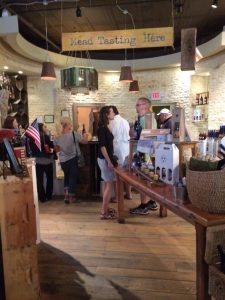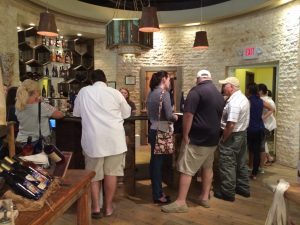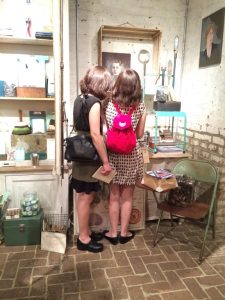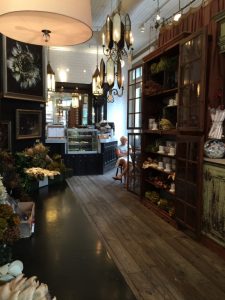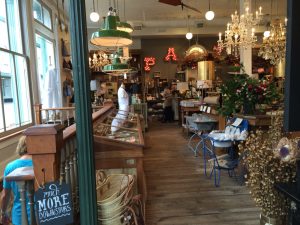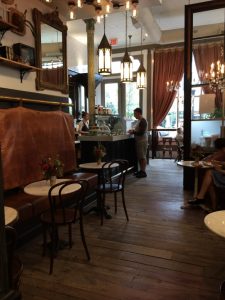I had the opportunity to visit Savannah last weekend. I had never been, so I stole an extra day to kick around and explore. With comfy shoes on my feet, I set off early with the map the hotel concierge, who declared she had been a Savannah tour guide for five years, had marked with all the must-see local landmarks such as the site where Forrest Gump waited for the bus. I found it a very genteel city, with small parks every block in both directions of the grid, and enough military artifacts scattered about to make West Point jealous.
During my wanderings, I discovered a complex called City Market. It was a city block full of small buildings interconnected to allow easy access from shop to shop. It felt like a retail community. I’ve encountered retail assemblages like this before – Bainbridge Island in Vancouver springs to mind – and have always enjoyed the meandering quality of the experience.
One of the shops proved irresistible and I ended up buying a very nice polished quartz and agate necklace that had been made by the shop’s proprietor. I found out the details through her niece, who was working the cash register, or rather, who used the cash register as a calculator and then rang the transaction through on her iPhone. Ever wearing the two hats of retail designer/critic and shopper, this experience triggered several thoughts:
-
If she’s using an iPhone for the transaction, why is the old NCR unit still in the store?
-
Where would I have looked for assistance (I needed her to retrieve the necklace from a locked glass case) if there had been no cash desk? That said, the cash desk really just served as a place for the young woman working to sit.
-
Where would I have gone, once the purchase had become certain, if there had been no cash desk? The shop was small, no stock area could be discerned. So the cash desk served not only as the retail equivalent of a pool’s lifeguard stand, but as the lone place to stash tissue paper, bags and boxes.
I noticed many of the stores I entered still had traditional cashwrap desks and almost as many that used WiFi-based mobile devices for payment transactions. But in each case, these relics of the past were more a place to contain staff and packaging than they were critical to the transaction itself. So why were they still there?
A store called Modern General had such personality from the street when I passed by the evening before, I made it an early destination to explore. It did not disappoint. The products were a mixture of past and present, all merchandised with a styling flair expected in a Southern home, making the store environment cozy and inviting. There was a bar with stools across one of the front windows where one could sit and watch locals stroll by. It made me think of Barney Fife and Floyd the Barber sitting on a bench outside the barber shop. (And if you don’t get that reference, I can’t help you out.)
I then wandered to the back of the store, where they had a bigger bar (dubbed the Dreamy Ice Coffee & Cookie Bar in gold letters) that beheld the most enormous cookies I had ever seen, each named with very whimsical monikers. Continuing my loop through the store, I encountered a third outpost: a very high (keep in mind I’m only 5-ft., 1-in. tall) and very large cashwrap desk. It left me with the feeling that the Dreamy Ice Coffee & Cookie Bar should have been renamed the Dreamy All-Purpose Service Bar. Not quite as catchy as the former, but I think you get my point. I couldn’t help feeling that this last outpost should have been removed to increase sales area and give the salespeople less places to hide.
Advertisement
Sometime later I wandered into the Savannah Bee Company. They sell honey, not bees. Seems all the bees may be gone in five to six years without serious intervention, but that’s a story for another time. I don’t know what it is about honey, but it always seems so attractive to buy. Again, there were several formal outposts of customer engagement: Upon entry was a sampling station off to the left side (a clever response to old “shopper observation law” that states most people skew to the right upon entry); midway back on the right was the cash desk (with a traditional register); and in the back left corner was a Mead Tasting Bar.
The layout was like bumper pool and effectively bounced the customer from one store associate to another, propelling you along on your journey of honey enlightenment. In the spirit of experimentation, I dutifully saddled up to the Mead Tasting Bar and handed over the five dollars to participate in the Mead Tasting. I figured it was a rare opportunity to see what Friar Tuck had made all the fuss about. The “bartender” then relayed the background on each of the five meads as I sampled my way through, and shared the above related to the fate of the bees. The experience impressed me enough that I was enticed to buy a bottle of the Tupelo Honey Mead, as this varietal contained the signature Tupelo honey local to Savannah, or so I was told by the “bartender.” (It immediately became the perfect gift for a friend who’s into wine.)
Never smart enough to stop shopping after partaking in alcoholic beverages (the meads are about 10 percent alcohol), I then found an adorable shop called Paris Market across the street. This shop also availed itself in the formula of customer engagement outposts: It had a central wrap station, a coffee bar at the back and a pastry counter at the front. It also had lots of happy salespersons (and I mean, genuinely happy) to show me anything that intrigued me.
Its downstairs was filled with curiosities – in the old sense of the word (scientific instruments, bones and the like in glass jars) – that I had to go explore. It was there that I came upon two young girls with their heads together, examining some object on display. The scene made me recall a Norman Rockwell image I had seen long ago and I couldn’t leave the spot from where I was observing without taking a picture. This is the effect shopping should have on people, and this is why stores – definitely stores like this one – will always be around.
It dawned on me that the customer experience in this town was carefully scripted and revolved around ensuring the customer felt welcomed into the community, was invited into the store and asked to stay a while. I know I’ll go back to Savannah and I will definitely visit these stores again when I do.
Kathleen Jordan, AIA, CID, LEED AP, is a principal in Gensler’s New York office, and a leader of its retail practice with over 24 years of experience across the United States and internationally. Jordan has led a broad range of retail design projects as both an outside consultant and as an in-house designer. She has led projects from merchandising and design development all the way through construction documentation and administration, and many of her projects have earned national and international design awards. Contact her at kathleen_jordan@gensler.com.
Advertisement
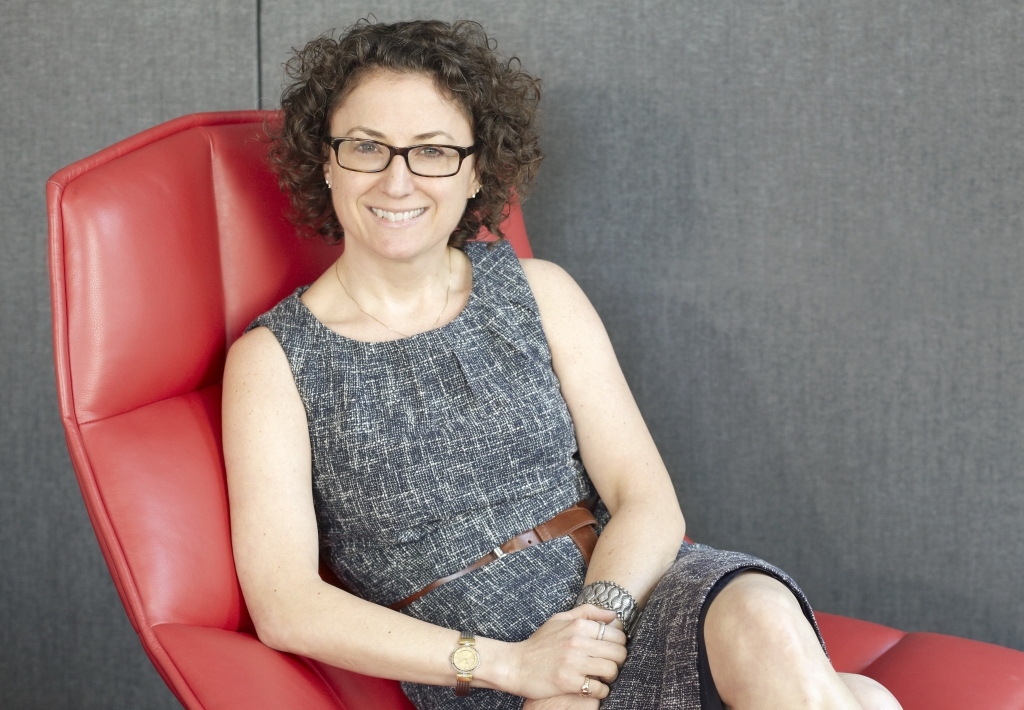

 Photo Gallery2 days ago
Photo Gallery2 days ago
 Headlines1 week ago
Headlines1 week ago
 Headlines2 weeks ago
Headlines2 weeks ago
 Headlines2 weeks ago
Headlines2 weeks ago
 Sector Spotlight2 weeks ago
Sector Spotlight2 weeks ago
 Headlines1 week ago
Headlines1 week ago
 Headlines3 days ago
Headlines3 days ago
 Headlines1 week ago
Headlines1 week ago

